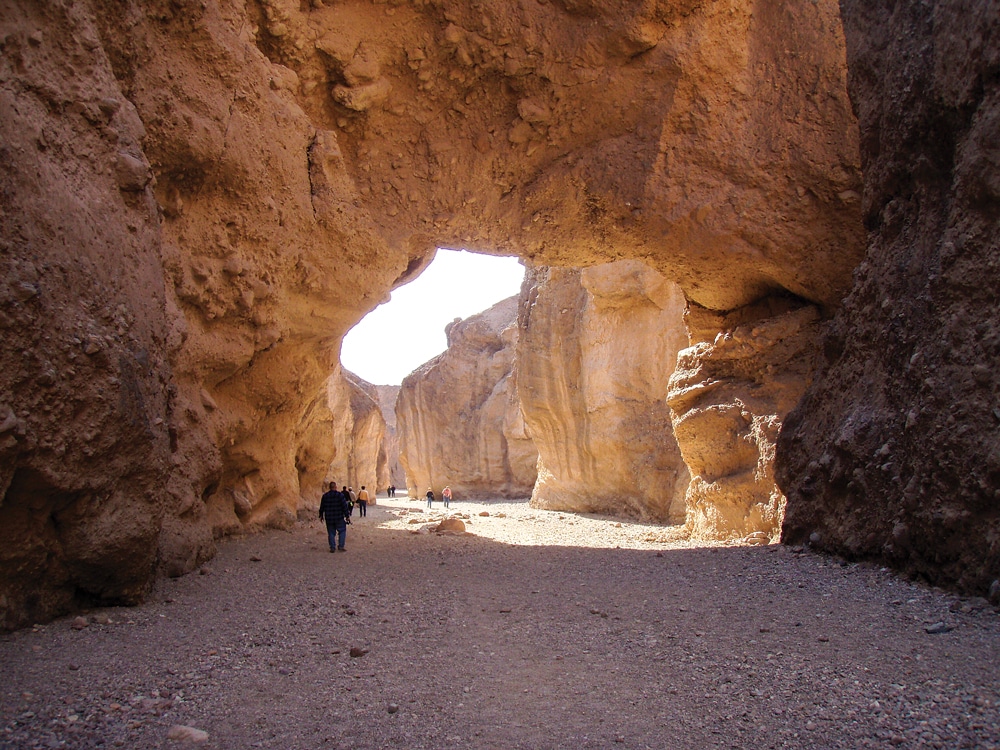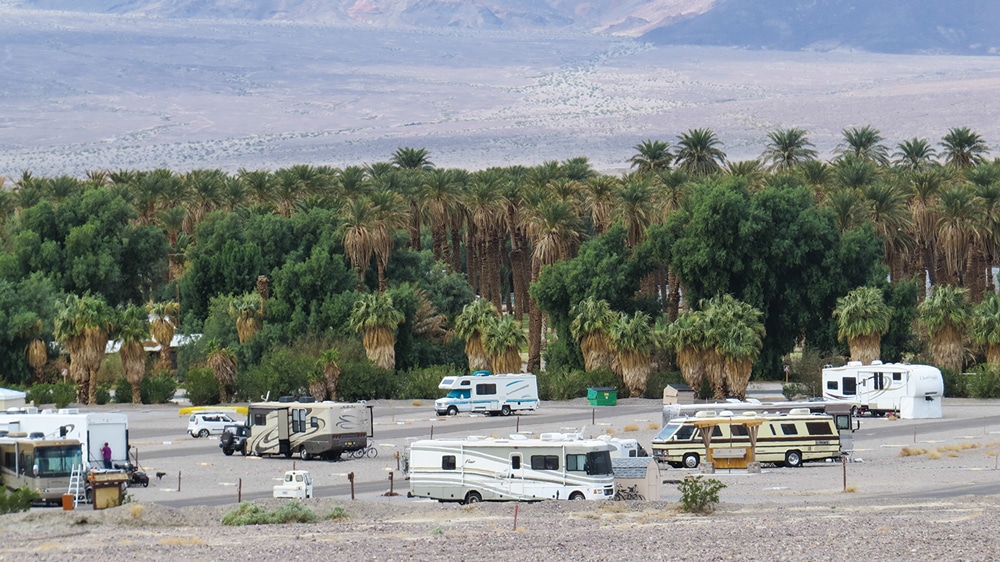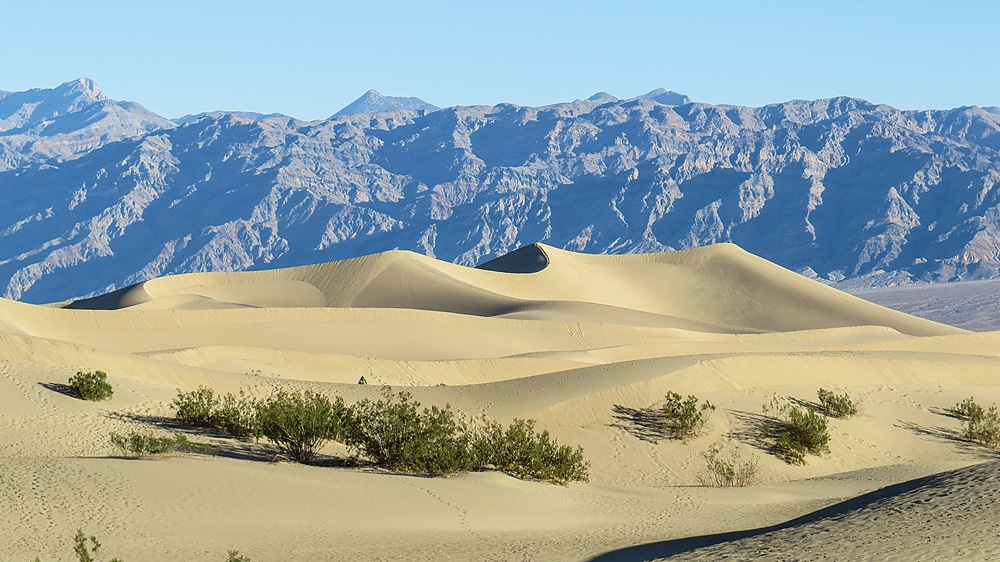A Land of Extremes on the California/Nevada Border
“Hottest, driest and lowest.” That pretty much sums up Death Valley National Park, but this enchanted land is so much more. The beautiful, and somewhat out-of-this-world valley, is also known as The Valley of Life to the Timbisha Shoshone tribe, its Native American inhabitants for centuries.
As annual visitors to Death Valley, my wife, Cheryl, and I receive a lot of questions from family members, friends and fellow RVers when planning our trip: Why Death Valley? What’s there to do? Why would you want to go to Death Valley? Our response is, “Death Valley National Park is a beautiful place with lots of activities to suit most any adventure-minded RVer.”
Located in the California/Nevada desert, Death Valley became a national monument in 1933; it received its upgraded national park status in 1994. The park has the unique distinction of being the hottest, driest and lowest place in North America and also holds the undisputed title as the Hottest Place on Earth. On July 10, 1913, the Furnace Creek Ranch weather station reached the record-breaking temperature of 134 degrees in the shade!
 However, that is just part of the park’s story. The valley has mild temperatures and pleasant weather October through April, with daily averages in the low 30s and 40s and highs in the low 60s to upper 80s. The valley actually has a longer season of pleasant weather then it does the more infamous summer months. It’s during these seven more temperate months that Death Valley is a pleasant place to visit.
However, that is just part of the park’s story. The valley has mild temperatures and pleasant weather October through April, with daily averages in the low 30s and 40s and highs in the low 60s to upper 80s. The valley actually has a longer season of pleasant weather then it does the more infamous summer months. It’s during these seven more temperate months that Death Valley is a pleasant place to visit.

Alien-like rock formations and valley floor surfaces that look more like a moonscape are just a few of the many out-of-this-world sights visitors to Death Valley National Park may encounter.
Death Valley National Park has 3.4 million breathtaking acres and six primary entry points. Once inside the park, you will be impressed with the ever-changing geological formations, vivid colors and extremely smooth roads that snake throughout its wilderness valleys and mountain ranges. These well-maintained roads will make you think your motorhome is riding on rails and make each day’s exploratory journeys a real driving pleasure.
There are two major activity hubs that offer all of the benefits and services found at any other national park. The largest, Furnace Creek, is located near the center of the park and houses the visitors center, borax museum, Furnace Creek Ranch and Furnace Creek Inn. Located at the ranch, Furnace Creek RV Resort has 26 full-hookup sites that can accommodate RVs up to 50 feet. Adjacent to the RV park is the new Fiddler’s Campground with 35 RV sites.
Although slightly smaller, Stovepipe Wells Village offers many of the same amenities as Furnace Creek; some visitors like to split their stay between the two locations. Stovepipe Wells Village has 14 full-hookup RV sites for $32.75 per night, adjacent to the general store.
First-time visitors to Death Valley’s Furnace Creek Ranch and Inn are amazed at the abundance of lush, green trees, bushes and grass throughout its grounds. The ranch’s amenities include a large general store, saloon, two restaurants, campgrounds with dry and full-hookup campsites, swimming pool, golf course, horseback riding, a fuel station with limited mechanical services, a post office, bike rental, Jeep rentals and more. This is a remote desert location and the prices of all goods and services bear this out, so plan wisely and pack in as much of what you think you will need and be prepared to spend a little extra for goods and services. The inn has an array of high-end resort accommodations and welcomes visitors to explore its historic buildings and grounds.

The park has the unique distinction of being the hottest, driest and lowest place in North America and also holds the undisputed title as the Hottest Place on Earth.
The National Park Service (NPS) also has three campgrounds located in this area: Furnace Creek, Sunset and Texas Spring. Most of the sites are first come, first served dry camping with the exception of Furnace Creek. There are dump stations and basic bathroom facilities at all three NPS campgrounds. Daily shower and pool passes can be purchased at Furnace Creek Ranch for $5. It is noteworthy that all of the water in the park comes from underground springs and the swimming pools are constantly replenished with warm spring water. You’ll feel like you’re basking in the fabled fountain of youth as you swim and play. No visit is complete without a dip in the pool and some quiet relaxation poolside after a long day of exploring.

Golfers enjoy breathtaking views and pleasant weather at the Furnace Creek Ranch’s 18-hole golf course.
If golf is your game, the ranch has an 18-hole oasis course, surrounded by spectacular desert and mountain vistas, and claims the title “World’s Lowest Golf Course,” at 214 feet below sea level. Even if you are not a golfer, a visit to the course is recommended for the views and lunch at the 19th Hole veranda-style bar and grill. Whether you sit next to the gas-log fireplace or at the counter overlooking the course, you will see golfers driving their carts up to the unique drive-thru bar to order food and drinks to go.
We could go on about the ranch and its facilities and we haven’t even touched on the other major guest support centers – Stovepipe Wells Village and Panamint Springs Resort, but just like being there, you have to remind yourself that you came to Death Valley to explore the many natural and historic sites the valley and surrounding mountains have to offer, not to spend all of your time “resorting it.”

Visitors to the Racetrack Playa marvel over the famous and mysterious moving boulders that have puzzled geologists for decades.
Death Valley has countless things to do: auto touring, biking, hiking, backpacking and exploring. Some of the activities in the Furnace Creek Area include hiking the easy trail at Badwater Basin (the lowest point in North America), visiting Harmony Borax Works, taking a scenic drive through multihued volcanic sedimentary hills on Artist’s Drive, shooting photos from Dante’s View (one of the great photographic spots in the park) at more than 5,000 feet above the valley’s floor, playing a round at Devil’s Golf Course (a vast rock-salt bed so rough that only the devil himself could play golf there), watching the sun rise or set at Zabriskie Point, and driving the Twenty Mule Team Canyon 2.7-mile route through otherworldly badlands.

Scotty’s Castle is undoubtedly the most famous and misunderstood man-made attraction in Death Valley National Park.
Some of the highlights in the Stovepipe Wells area include Mesquite Flat Sand Dunes (ever-changing 100-foot-high dunes), Salt Creek (the only home to the rare Death Valley pupfish), Titus Canyon (at 27 miles long, it is the park’s largest and most diverse canyon), and Rhyolite (the best-preserved ghost town in the area).
In the Panamint Springs area, popular sights are Father Crowley Vista (a lava-flow viewpoint that overlooks the colorful Rainbow Canyon), Wildrose Charcoal Kilns (10 well-preserved large, beehive-shaped structures constructed in 1876 to support the silver and lead ore mining in the valley), and Aguereberry Point (the highest overlook in the park at more than 6,000 feet).

At Wildrose Charcoal Kilns there are 10 well-preserved 30-foot-tall beehive-shaped charcoal-producing kilns that date back to 1877.
Our last must-see area is Scotty’s Castle. Take a ranger-guided tour of the impressive 1920s castle that was thought to be built from the hidden gold mine of Walter Scott, the infamous Death Valley Scotty, but in reality was the vacation home of one of Scott’s friends, Albert Mussey Johnson. Also in the area is Ubehebe Crater, a 600-foot-deep volcanic crater that is only a few hundred years old, and The Racetrack – home to the mysterious sliding rocks that leave long trails in their path!
We have just scratched the surface on everything there is to see and do in Death Valley. To learn more, visit the park’s website and plan your visit. Then, maybe soon you will be one of the people who say, “I’m going to Death Valley and let me tell you why!
For More Information
Death Valley National Park | 760-786-3200 | www.nps.gov/deva

An overview of Sunset Campground with Furnace Creek Ranch’s date grove and valley floor in the background.


